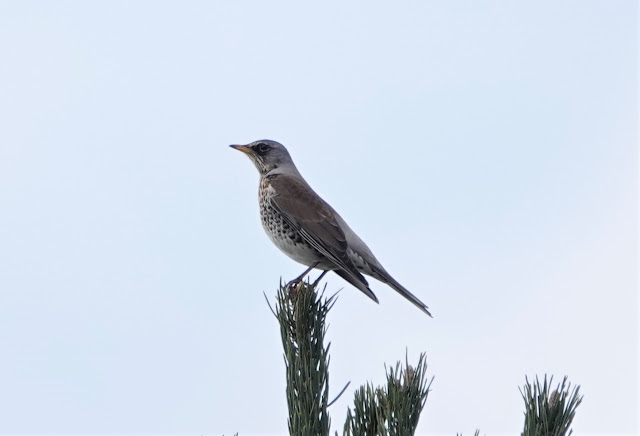 |
| A Fieldfare "the Royal Thrush" (Martin Kelsey) |
There are moments and places in Extremadura which take me far from the familiar
dehesas, plains and Mediterranean scrublands close to home. Indeed, one of the profound attractions of Extremadura's landscape diversity is quite simply that. I do not need to travel a long way for fresh encounters. Yesterday through winter banks of fog I headed north to the very limits of the region. Just shy of the border with Castille y Leon, I took a narrow winding mountain road through the village of La Garganta, whose population of about 400 people live at an altitude of over 1100 metres, the second highest settlement in Extremadura. Many of the inhabitants work higher still, as my route ascended I passed smallholdings and mountain meadows, patches of forestry land, a goatherd with his animals.
 |
| The view to the west (Martin Kelsey) |
Now well above the fog, I had a view westwards across the mountains of Las Hurdes and Gata, as far as distant Portugal. The classic temperature inversion was easily measureable: my car thermometer had shown about 3º C in the low-lying Ambroz plain, whilst now hundreds of metres higher up and with snow lying on the hillsides above me, it showed 8ºC. There was the gentlest of high cloud above me which hardly moved, thanks to the beautifully still conditions. Pull-offs along the way gave me the opportunity for glimpses into the past: a seriously impressive
Pozo de Nieve (ice-house) and a corral for trapping wolves (a noticeboard told me that the last wolf hunt locally took place in the 1960s).
I stopped at a small pass from which the road would start its descent. The border with Salamanca province lay barely a kilometre from where I stood. I love to potter around here at in the summer: the place is superb for butterflies and the tangles of bramble at the edges of the hayfields provide good vantage points for Red-backed Shrikes. But this was a perfect morning for a good winter walk and I took an eight-kilometre circular route, looping along the western flank of the Gredos mountains. Wind and frost-blasted shoulders of rounded granite looked like hilltop turrets, sentinels over the lowlands, which were rippled by sodden mists. A vaulted silence of pines was broken by the purrs of Crested Tits and squeaks of Goldcrests. A party of Red Crossbills came up from puddles on the path.
 |
| Terebinth berries, pines and oaks (Martin Kelsey) |
Then I was back in open ground, winding around a valley with a cascading tumble of water, and mountain slopes clad by Pyrennean oak, still russet-toned with a few stubborn leaves left hanging. Scrubbier terrain had rosehips and terebinth trees, the latter with pea-sized red berries. I watched a group of Bramblings and Chaffinches feed on this, hanging downwards to reach the fruit in the manner of Siskins. The bleak, simple calls of a pair of Bullfinches distracted me and I watched them land briefly at the top of a bare tree down the slope.
 |
| Pockets of meadows (Martin Kelsey) |
Lying between the ravines were pockets of small meadows and stone-walled enclosures. Here groups of cattle grazed. A trailer stood beside a gate, full of straw bales. Where fodder had been spread in the corral, flocks of small birds were dropping in to feed. I stopped to watch them: waves of motion as they rose to pause on bordering bushes when alarmed, before swooping down again to shuffle around on the ground. Mostly they were Chaffinches and Rock Buntings, but a heftier bunting flew up into the closest tree. It sat facing me, mostly hidden by amber leaves. It was heavily streaked with a bold yellowish malar stripe. It moved again, and this time sat with its back to me, showing its streaked olive back and, yes, a reddish brown rump. This was a Yellowhammer, an extremely rare winter visitor to Extremadura and the first I had ever seen here. Barely had I time to absorb what I was looking at before it rejoined the other birds at the far end of the enclosure. As I searched for it, something startled the flock and they all flew up into more distant trees. Then I realised that there was not just one, but indeed two Yellowhammers present, sitting close to each other.
 |
| A winter Yellowhammer in Extremadura (Martin Kelsey) |
As I completed the walk, the colours and smells of soggy woodland and moss, the touch of the moist mountain air carried me far from Extremadura, to more northern latitudes. My encounters through the morning had reinforced this sensation. Many of the birds I had seen occur here only in the winter and some barely reach this far south. My sense of a wilderness in winter was captured in one final climax when a dispersed band of thrushes flew over as I reached the car. Amongst the grating Mistle Thrushes and sighing Redwings were the
chack-chacks of Fieldfares. Called the "Royal Thrush" in Spanish, it had been many many years since I had last seen one here. To me, they were nomads, exuding space and freedom, high above the canopy of pines. I stood in border country: geographically, ecologically, and sensually.








Comments
This morning, I was driving across the Somerset Levels and a noisy flock of maybe 150-200 Fieldfares flew over and a group of them landed in a field near the road to mingle with a few Redwings. After pausing a short while to watch them, I was reminded of this blog and decided to read it again. You really do have a lovely way with words that conjures up visions of the many and varied landscapes that Extremadura can offer as well as its wonderful flora and fauna.
Best Regards
David Williams